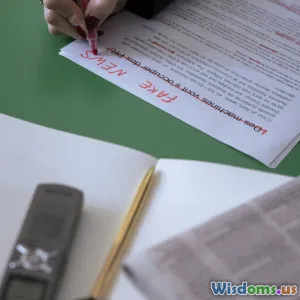
Fact or Fiction How to Evaluate Online Information Effectively
7 min read Master the art of discerning fact from fiction online with proven techniques to evaluate digital information profoundly and accurately. (0 Reviews)
Fact or Fiction: How to Evaluate Online Information Effectively
Introduction: Navigating the Digital Maze
Every day, billions scour the internet for answers. From breaking news to health advice, and social trends to academic research, the web inundates us with information. But with such magnitude, how do we sift through the flood and separate fact from fiction? Misinformation and disinformation have emerged as pervasive challenges, shaping opinions and even influencing elections and public health.
According to a 2023 study by the Pew Research Center, 64% of adults say fabricated news leads to confusion about basic facts, and over 50% have unknowingly shared false content. This highlights an invaluable skill we all need: the ability to critically evaluate online information with confidence and clarity.
This article unpacks essential strategies to decode the digital information ecosystem, equipping you with tools to judge authenticity, credibility, and accuracy effectively.
Understanding the Landscape: Why Misinformation Thrives
Before diving into evaluation techniques, it's critical to grasp why misinformation proliferates online:
- Low barriers to publishing: Anyone can post content, regardless of expertise.
- Algorithm-driven amplification: Social platforms prioritize engagement, sometimes boosting sensationalist or false stories.
- Cognitive biases: Confirmation bias leads people to accept information aligning with their views without scrutiny.
Example: The ‘Pizzagate’ Incident
In 2016, a fake news conspiracy alleged a Washington, D.C. pizzeria was a child trafficking hub. Despite being debunked, it caused real-world harm, including a violent incident. The story spread rapidly because it targeted emotionally charged themes and appealed to confirmation biases.
Recognizing these mechanics is foundational to building your information vetting muscle.
Key Strategies to Evaluate Online Information
1. Assess the Source Credibility
Start by asking: Who is behind the information?
- Check the website domain and ownership.
- Verify if the author has qualifications or expertise.
- Look for institutional backing (e.g., universities, government sites).
Example: A health-related claim from the Mayo Clinic's website is far more trustworthy than a random blog.
2. Evaluate the Evidence and References
Reliable articles cite sources, studies, or official data.
- Are claims supported by primary research?
- Check if cited studies are peer-reviewed and recent.
- Beware of cherry-picked data or out-of-context statistics.
3. Check for Objectivity and Bias
- Identify the purpose: Inform, persuade, or sell?
- Does the content use emotionally charged language or sensationalism?
- Cross-check facts with multiple reputable outlets.
4. Examine Publication Date and Timeliness
Older articles may not reflect current evidence. This is crucial in fast-evolving fields like technology or health.
5. Look for Editorial Standards
Legitimate news organizations often have editorial reviews and fact-checking:
- Are there corrections or disclaimers?
- Does the site adhere to established journalistic standards?
6. Verify Through Fact-Checking Platforms
Use independent fact-checkers such as Snopes, FactCheck.org, or PolitiFact to substantiate claims.
7. Practice Lateral Reading
Rather than consuming information passively, open new tabs to research the source or related articles alongside the primary content.
Real-World Application: A Case Study
You encounter an article titled: "New Research Shows Eating Chocolate Boosts Brain Function."
Step 1: Scrutinize the source. It’s published on a website called BestHealthyLiving123.com, which appears to focus on wellness but lacks clear author credentials.
Step 2: Evaluate the evidence. The article quotes a study but provides no direct link or citation.
Step 3: Cross-reference the claim. Searching PubMed and Google Scholar reveals a small 2021 study from a reputable university indicating moderate cocoa flavonoids might support cognitive performance.
Step 4: Consider the article’s tone. The language is hyperbolic, claiming chocolate is a "miracle food," suggesting exaggeration.
Step 5: Check fact-checkers. No specific fact-checks exist but mainstream health news treat the claim cautiously.
Conclusion: The underlying research has some merit, but the article overstates conclusions without nuance, indicating it’s partly factual but poorly presented.
This approach prevents misinformation absorption while recognizing kernels of truth.
The Role of Digital Literacy and Critical Thinking
Evaluating information online isn’t just a mechanical checklist—it demands nurturing a critical mindset:
- Question rather than accept.
- Be aware of your own biases.
- Continually update your knowledge.
Richard Saul Wurman, creator of TED, once said, “Information is not knowledge.” This reminds us that data is abundant, but understanding requires active interpretation and verification.
Educational institutions worldwide are integrating media literacy programs to cultivate such skills among younger generations, emphasizing the importance for all ages to remain vigilant.
Conclusion: Empower Yourself Against Misinformation
In a world overflowing with data, discerning truth is both an essential right and responsibility. By applying structured evaluation techniques—scrutinizing sources, verifying evidence, acknowledging biases, and using trusted fact-checkers—you empower yourself to navigate the digital information landscape confidently.
Start today: the simple action of pausing before sharing or believing online content can contribute to a healthier, more informed community. Remember, the power to decode fact from fiction lies in your critical eye and inquisitive mind.
The true wisdom is not in the endless consumption of information but in the measured, thoughtful evaluation of what is real.
References
- Pew Research Center, "Navigating Digital Misinformation," 2023
- Vosoughi, S., Roy, D., & Aral, S. (2018). The spread of true and false news online. Science, 359(6380), 1146-1151.
- Wurman, R.S., quoted in "Information Anxiety," 1989.
- Snopes.com Fact Checks
Empower your digital literacy—separate fact from fiction with a practiced lens today.
Rate the Post
User Reviews
Popular Posts

















